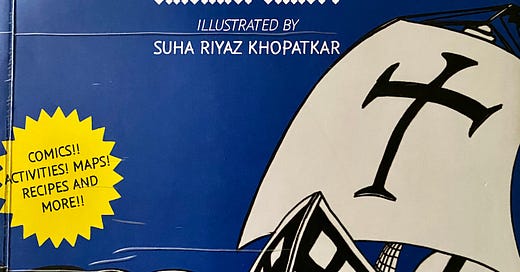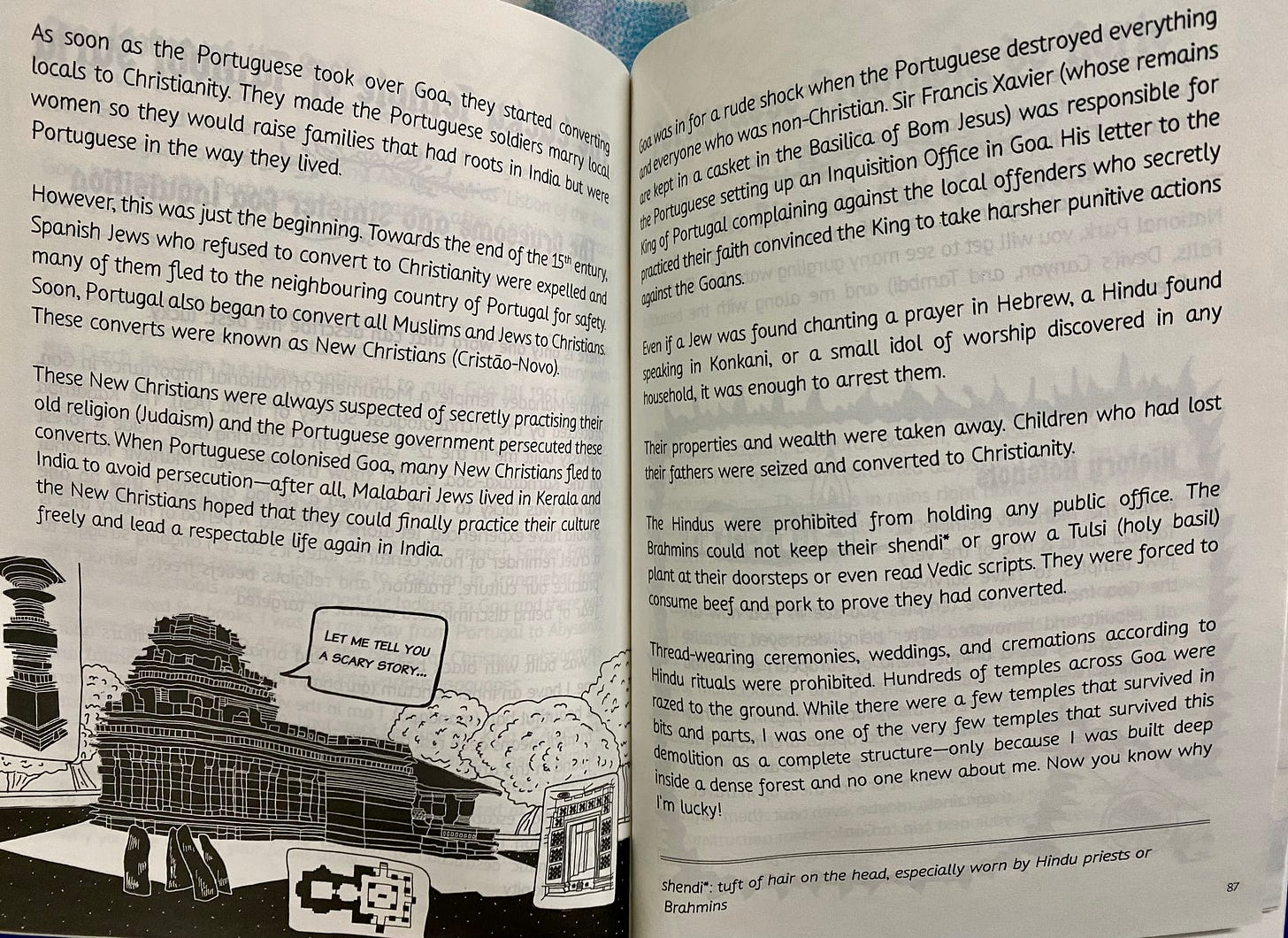#403 - Batata, Pao And All Things Portuguese
by Vaishali Shroff and illustrated by Suha Riyaz Khopatkar
“Batata, Pao and All Things Portuguese” by Vaishali Shroff and illustrated by Suha Riyaz Khopatkar. Published by the People Place Project. A concise book about the lesser known story of the Portuguese rule in India that lasted for over four centuries.
The colonial era of India began in 1498 when Vasco da Gama finally found the sea route to India. Though the Portuguese were the first to arrive in India even before the Mughals, we hardly know much about their rule or anything about them for that matter as compared to the Mughals or the British. This neglected part of history is what this book is about. The book is divided into four parts which talk about the following aspects of the Portuguese - the arrival, rise, fall and the things that they left behind as reminders of their stay here.
Each of the chapters across the four parts is narrated by places, monuments, trees and even random objects at times which have been a witness to the events that took place. For instance the caravel Sao Gabriel (light and fast ship) recounts how Vasco Da Gama came to India for the first time. A brick in the fort wall of Bassein describes how the Portuguese came to occupy the place. While the Tali Shiva temple tells us about Da Gama’s meeting with the Zamorin of Calicut, the hidden Mahadeva temple of Tambdi Surla in Goa recounts how it is lucky to have survived the dark period of the Goan Inquisition. The picture painted is one of pristine places and how bloody battles were fought here. All in the name of sea trade control and hunger for power. And the religious fanaticism where there was no room for faiths other than Christianity. A memorial standing in Goa narrates how the Portuguese eventually left or were rather ousted from India in 1961. What do the Batata and Pao in the title of the book have to do with this historical period? What else do we get to encounter in this Birds Eye view of Estado da India (the Portuguese “State” of India headquartered in Goa)? What are the reminders of this period that we get to see even today? How has the Portuguese occupation changed even our cuisine so fundamentally that it’s difficult to imagine it without some of the Portuguese imports? Read this gripping book to experience and understand this part of history which is from a perspective never done before at least in children’s books. I am sure many adults themselves (including me of course!) are not aware of quite a few things mentioned in this book.
My almost nine year old and I just couldn’t get over this book. Too many personal connections and too much to just absorb. We loved the book would be an understatement. The book was quite engrossing and we appreciated the way in which topics have been categorised and dealt with in terms of illustrations. The narrative is interspersed with reimagined and dramatised accounts of conversations between characters portrayed in graphic format to make it more interesting for the children. There are activities, maps and recipes too. How I wish history could be taught like this everywhere! This would make it so appealing :) And, yes, this is the second book that we have read this year that poses a question in the form of whether Vasco Da Gama was the great explorer as described everywhere in history books or a bloodthirsty pirate after all? Something that is worth pondering about. The first book was “The Ghost of Malabar”.
In here is a personal connect for me and our community. We speak Konkani at home and our ancestral roots, including temples of family gods are in Goa. The Goan inquisition is one of the darkest and horrible periods of our history and something that is not talked about. There is hardly any awareness about it. I am glad to see it come through in this book albeit briefly (given that it is a children’s book I suppose). But this is something that a lot more people should know about and I am glad I could use this book to open up this part of our community’s history to my son. During this period, most of our temples were destroyed in Goa and many of the people from our community were forced to either flee and seek refuge elsewhere. This is why we ended up spreading all across the coast from Maharashtra to Northern Kerala. The temples that we find today in Goa were rebuilt later and idols which had been hidden were reconsecrated. Goa is not just about sun, sand and the sea. It has had a gruesome past!
The book is definitely a “MUST READ” and deserves to go everywhere. A couple of days ago, Vaishali Shroff won the award in the children’s books category for this book in the JK Paper Auther Awards 2023. Thank you Vidya Mani of Funky Rainbow for recommending this lovely book in one of the buzzaars and for having Vaishali Shroff as a part of your buzzaar! We were pleased to get a signed copy of the book when we ordered it from Funky Rainbow :)
Recommended Age
The book is apt for children aged 9 and above.






